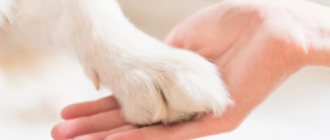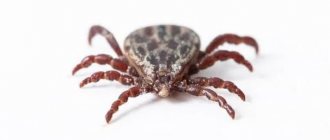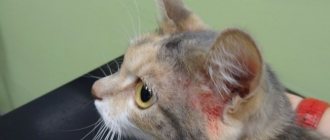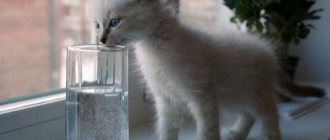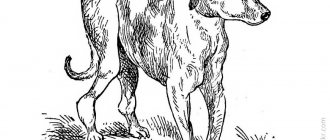Causes of tachypnea What you should pay attention to Diagnosis Treatment Care Tachypnea, or polypnea, is rapid breathing. Rapid breathing, unlike shortness of breath (an unpleasant sensation associated with difficulty breathing), is not always a sign of illness.
When breathing, air enters from the atmosphere into the lungs, and gas exchange occurs between the blood entering the lungs and the air. From a physiological point of view, more frequent breathing is necessary with increased oxygen consumption and increased blood flow. Therefore, there are several natural reasons that lead to rapid breathing in dogs - physical activity (games, running), increased excitability (caused by any strong emotions as a result of any event - it can be fear or joy, for example, from the return of the owner) , a dog’s breathing may also become more frequent during estrus (estrus), pregnancy and lactation. An increase in air temperature also causes rapid breathing. In all other cases, tachypnea can be caused by pathology of the respiratory or cardiovascular system. At the same time, the presence of any other factor (estrus or heat outside) cannot guarantee that the dog’s rapid breathing does not have a pathological cause. It is especially important to carefully monitor brachycephalic dogs (with a shortened muzzle), and breeds predisposed to cardiac pathologies - German shepherds, boxers, wolfhounds and all giant breeds.
Normally, a dog can make up to 24 breathing movements per minute. To count the number of breathing movements, you need to wait until the dog falls asleep or remains at rest for a long time. When lying on your side, you can observe the movement of the abdomen; when moving upward, you inhale. It is better to count several times, timing the minute using a stopwatch. It is also important to monitor if your pet has difficulty breathing, shortness of breath, or small frequent breaths even at rest. With pathological causes of rapid breathing, other associated symptoms are usually observed.
Causes of tachypnea
Upper respiratory tract diseases
- Diseases of the nose and paranasal sinuses (infection, narrowing (stenosis), inflammation, cancer)
- Diseases of the soft palate (soft palate hypertrophy associated with brachiocephalic syndrome)
- Diseases of the larynx (edema, collapse, paralysis, laryngospasm)
- Diseases of the trachea (neoplasms, collapse, foreign bodies)
- Compression of the upper respiratory tract caused by changes in the chest (enlarged lymph nodes, for example due to a tumor)
Lower respiratory tract diseases
Diseases of the lower respiratory tract are divided into: obstructive (when something blocks the respiratory tract) diseases and reconstructive (when the ventilation ability of the lungs is limited) diseases.
- Bronchial diseases (bronchitis, cancer, parasites)
- Lung diseases (fluid in the lungs, pneumonia, bleeding, blood clots, parasites, cancer and volvulus)
- Pleural effusion (fluid in the chest cavity)
- Pneumothorax (air in the chest cavity)
- Diaphragmatic hernia
- Enlarged lymph nodes and tumors in the chest cavity.
Non-respiratory causes (outside the respiratory system).
- Heart diseases (congestive heart failure, arrhythmias)
- Neuromuscular diseases (trauma, cancer, inflammation)
- Metabolic/endocrine diseases (diabetes mellitus, Cushing's disease)
- Hematological diseases and conditions (anemia)
- Diseases of the abdominal organs (neoplastic masses, enlarged organs, fluid in the abdominal cavity, bloating)
- Pain
- Fear, stress
- Exercise stress
- Heat
- Obesity
Tachypnea may have little or no effect on the body, especially if it is caused by fear or stress. And, conversely, it may be a symptom of a serious, life-threatening disease. Therefore, you should not ignore rapid breathing, especially if it persists for a long time or progresses to shortness of breath.
Encouraging behavior
So, when does your dog breathe with its mouth open? A dog's mouth breathing is not a problem in itself. In fact, it serves the important purpose of keeping the dog's body temperature at a normal level. The only time you need to worry about a warm or exercising dog breathing with its mouth open is when it starts to show signs of overheating. If this happens, your first task is to take your dog to a cooler area. You may also need to encourage her to use alternative means of cooling.
Dogs can cool down by lying on a cool surface, such as a tile floor. Dogs often do this naturally, but if your dog seems in danger of overheating, you may need to take him to a suitable surface. If your car has already cooled down, you can help your dog cool down by driving him with the window down. Contact with moving air will allow your dog to lose heat faster. Let him breathe throughout the entire process.
© shutterstock
If your dog is panting with an open mouth due to anxiety or illness, the panting itself is not a problem, but the problem requires attention. Stressed panting can be the easiest way to relieve it, as it often only requires removing the dog from the situation. However, if the anxiety seems chronic, you may need to call your veterinarian. A visit to the veterinarian is also required if the dog experiences pain, vomiting, diarrhea or other signs of illness.
Diagnostics
The first thing you need to check is whether there are objective reasons that provoke rapid breathing (heat, stress, significant physical activity) and, if there are, eliminate them. If tachypnea persists after external causes have been ruled out, does not improve over time, or worsens, you should contact your veterinarian and have your pet examined.
- A general clinical blood test, biochemical analysis of blood and urine are performed first. Abnormalities may indicate causes of tachypnea such as anemia, infection and diabetes.
- Test for helminthic infestation
- Study of the gas composition of arterial blood.
- It is important to perform a chest x-ray. This will help rule out a foreign body in the upper respiratory tract or a tumor.
- Ultrasound of the heart and chest cavity.
- Thoracentesis (pleurocentesis) - puncture of the chest wall with collection of fluid or pus accumulated in the pleural cavity and its subsequent analysis
- More complex diagnostic methods involve the use of rhinoscopy or tracheobroncoscopy (an endoscopic method for examining the lumen and mucous membrane of the bronchi and trachea) and CT.
The dog breathes rapidly, sticks out its tongue and trembles
Owners of small dogs, such as the Yorkshire Terrier, often experience rapid breathing. Most often, such dogs are kept as a home pillow or toy.
The dog breathes frequently with its tongue hanging out and trembles:
- Therefore, they receive very little attention. The main task of the owners in this case is to feed and groom the dog. However, it is worth remembering that this dog also needs frequent walks and muscle training.
- Therefore, it is necessary to walk them as often as large breeds of dogs. That is three times a day. It is advisable to do this not for 10 minutes, but much longer, so that the dog can run properly and tense his muscles.
- It is precisely because many owners keep such dogs in greenhouse conditions that they often go to the toilet in the diaper, and not outside, the dogs become overgrown with fat and become obese. Problems with the cardiovascular system appear. This is why rapid breathing may occur.
Almost all dogs in the summer, due to the presence of a thick fur coat, can breathe very quickly, sticking out their tongue. This is not a pathology, try to save your pet from the heat.
Treatment
It is best if the causes of tachypnea are identified and eliminated. This, for example, could be heat, stress or physical activity.
Symptomatic therapy is advisable in situations where the cause of rapid breathing is not obvious and time is needed to find it.
Oxygen therapy will have a positive effect on the animal, especially if its condition is assessed as severe.
Infusion therapy is used to treat dehydrated animals or dogs suffering from systemic diseases such as uremia.
Conclusion
As a dog owner, you should always be aware of whether your dog's behavior signals any problems. Even shortness of breath can be a sign that something is bothering your dog, be it excessive heat or illness. However, be careful not to jump to conclusions. In most cases, a dog is breathing with its mouth open - this is simply the dog's body doing what it is designed to do. In most cases, shortness of breath does not mean your furry friend is sick!
How to deal with stress in dogs
Behavior modification is the best way to relieve anxiety in animals. Protocols typically involve training dogs to remain calm when exposed to mild versions of their triggers, rewarding them, and gradually increasing the intensity of their exposure while the dog remains calm.
However, dogs sometimes have difficulty remaining calm under even the mildest stressors. This is the time when medications and other anxiety-relieving foods become invaluable. What do we recommend giving your dog during a stressful situation?
What is a sedative?
A sedative is a medicine (used by people or animals) that helps them relax and reduce anxiety. Unlike a real anesthetic, which makes the animal extremely sleepy and unresponsive, a sedative allows the dog to be calm while still allowing him to be aware of what is happening and interact with the world around him. Sedatives are generally NOT addictive.
Lack of appetite and trembling in a Pekingese
Good afternoon. Help me please. We have a Pekingese, he is 2 years old. Everyone was vaccinated at 2-3 months of age. Three days ago in the evening I bathed him, he felt fine. The next morning I was hot and shaking, in the evening everything seemed fine again, I ate, played, went outside. But today everything is very bad: he’s shaking, he’s not eating anything, he’s not drinking water. We went to the clinic, took the temperature - normal, stool normal. The doctor gave us two injections - one anti-inflammatory, the other an anesthetic, and prescribed us Phosphalugel and kefir. I came home from the clinic and gave him kefir to drink, and after half an hour the dog vomited, the kefir was yellow. What should I do, help? The doctor said it was a cold or kidney disease.
Answer 3
Puppies, old dogs, and small dogs with reduced immunity suffer from similar diseases. Indicates a cold, lethargy, lack of appetite. The condition sometimes passes unnoticed, without consequences. Weakened immunity allows the disease to take a severe form.
Diet is important. Lack of essential minerals, vitamins and other essential substances weakens the body. Resistance to bacteria decreases. Germs win.
A cold is a consequence of hypothermia. For example, Pekingese dogs should not be taken for a walk after bathing. Other dogs too. Pekingese have a higher body temperature and are therefore susceptible to hypothermia. Drafts have a negative impact. Pets need to be hardened starting from childhood. After washing, you need to dry the dog in a warm, dry room, without drafts.
Representatives of popular breeds are owners of poor health. Breeders sin by lack of attention to the quality of health of their offspring. Puppies are born weak and susceptible to disease. The problem is relevant and widespread.
Older dogs are susceptible to germs and viruses. Immunity is weakened. General physical condition is not good. It's hard to fight. Requires care, care, attention.
Some individuals are guilty of laziness. Inactivity ruins your health. Requires active rest, physical exercise, long walks. Your strength will increase and your health will improve.
Affects the state of the place of sleep. You cannot place a bed in a cold, damp room. It should be dry and warm. Ventilated place, drafts are prohibited. It should not be placed near a radiator. Neutral temperatures are required.
Sick dogs can infect your pet. Street contact is dangerous. The transfer of infection, bacteria, fleas and parasites is possible during play. An organism with a weak immune system is not a fighter.
Cold symptoms
A hot, dry nose is alarming. This is a symptom of the disease. Medical examination required. Additionally, the dog experiences chills and weakness. The absence of other symptoms indicates fatigue.
There are many dog breeds, showing different weights, heights, and body characteristics. It is necessary to know the normal body temperature. Elevated temperature is an alarming signal.
The presence of the disease is accompanied by strange behavior. Lethargy, laziness, and apathy appear. The four-legged friend refuses to eat or play. The dog whines and growls.
Symptoms include discharge from the eyes and nose. The dog has snot, tears, and drooling. The presence of purulent and bloody impurities is dangerous. Urgent medical assistance is required. The presence of the virus is accompanied by colorless discharge. The dog sneezes, coughs, spewing out clear liquid.
An animal that has caught a cold is shivering and feverish. The acute phase is passing. Self-medication is ineffective. You will need to seek medical help. A symptom of a cold is dull fur. Sluggish, rumpled appearance.
First aid
A sick animal needs water and a balanced diet. Those who refuse to eat are given meat broth. The liquid is heated to body temperature. Pour in carefully from the side of the mouth.
The bed is moved to a warm, dry room. Drafts are eliminated. The bed is a heat-preserving material. Warmers and heated packaged salt are placed on the shuddering animal.
Your pet's body will respond positively to the massage. It should be accompanied by drinking water. Massage movements circulate blood and lymph, have a tonic effect, and relax. Nasal and eye secretions are wiped with clean tissues. Moisturizing drops help.
The animal should be taken to the doctor wrapped in a blanket. Along the way, the patient is stroked and reassured. Acute symptoms require urgent intervention. The doctor will examine you and prescribe treatment.
Consequences, prevention
Untreated ailments develop into serious illnesses. A cold turns into kidney disease, pneumonia and others. Regular colds reduce immunity. The body is weakened.
Regular walks and physical activity improve your health. Fresh air strengthens your four-legged friend. A balanced diet is part of health prevention. Living conditions ensure the absence of illness.
Excessive care makes a dog sissy. Excessive wrapping in clothes, short walks, and overfeeding have a negative impact. Thermoregulation is disrupted. Such an individual is susceptible to infections, viruses, and temperature influences.
Puppies are gradually hardened. Each walk increases the time spent outside. Additional clothing is a last resort, except for owners of decorative dogs. Nutrition includes the necessary micro and macroelements. Water must be freely available. Plus, regular visits to the veterinarian are necessary.




